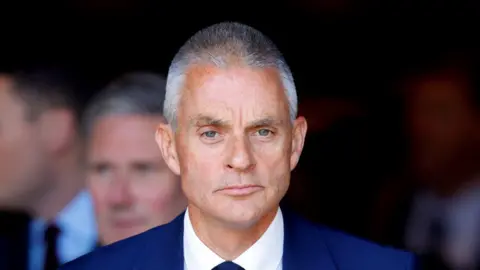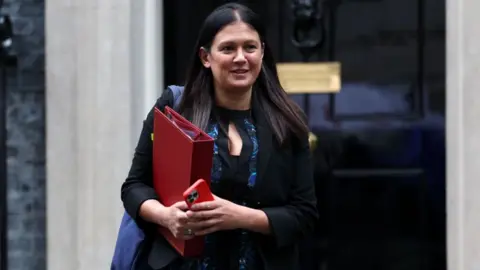
 Getty Images
Getty ImagesCulture Secretary Lisa Nandy will speak with BBC director general Tim Davie after former newsreader Huw Edwards pleaded guilty to three counts of making indecent images of children.
The pair are expected to speak over the phone on Thursday and discuss the organisation’s handling of the case.
It comes after it emerged on Wednesday evening that the BBC was told Edwards was under suspicion of child abuse image offences.
The BBC said it knew Edwards had been arrested on suspicion of serious offences in November – something only made public this week – without detailing what the offences were.
In its statement, the BBC added that the presenter would have been dismissed had he been charged while still employed by the BBC. Edwards resigned in April and was charged in June.
The corporation faces questions over why it did not sack Edwards when it knew of the arrest and why it continued to pay Edwards his salary for a further five months.
Edwards resigned from the BBC in April citing medical advice. He had not been on air since July 2023, when he was named as the man at the centre of a separate case involving explicit images of a young person.
BBC News was not aware of the arrest nor charges against Edwards until they were made public on Monday. BBC News is editorially independent when reporting on the BBC.
Last week, the BBC’s annual report revealed Edwards received between £475,000-£479,999 between April 2023 and April 2024, an increase of £40,000 on the previous year.
A BBC source said the corporation “did not believe there was any legal recourse to recoup any previous pay or future pension money” from Edwards.
 Getty Images
Getty ImagesAt Westminster Magistrates’ Court on Wednesday, Edwards admitted having 41 indecent images of children, which had been sent to him by another man on WhatsApp.
They included seven category A images, the most serious classification – two of which showed a child aged between about seven and nine.
Category A images show serious abuse including penetrative sexual activity.
He also had 12 category B pictures, which involve non-penetrative sexual activity, and 22 photographs in category C, which covers other indecent images. The category B and C pictures showed children aged between 12 to 15.
After Edwards pleaded guilty on Wednesday, his former employer said: “The BBC is shocked to hear the details which have emerged in court today. There can be no place for such abhorrent behaviour and our thoughts are with all those affected.”
It said it had been “made aware in confidence” in November 2023 that Edwards “had been arrested on suspicion of serious offences and released on bail whilst the police continued their investigation”.
“At the time, no charges had been brought against Mr Edwards and the BBC had also been made aware of significant risk to his health,” the statement continued.
The corporation noted: “If at any point during the period Mr Edwards was employed by the BBC he had been charged, the BBC had determined it would act immediately to dismiss him. In the end, at the point of charge he was no longer an employee of the BBC.”
 EPA
EPAAfter the hearing, police said the investigation into Edwards began after a phone seized as part of an unrelated probe revealed the broadcaster’s participation in a WhatsApp conversation.
The force said 25-year-old convicted paedophile Alex Williams was the man who shared images with Edwards.
Williams pleaded guilty to possessing and distributing category A, B and C images as well as possessing prohibited images of children.
He was sentenced to a suspended 12-month jail sentence at Merthyr Tydfil Crown Court in March.
‘Making’ indecent images – what does the law say?
Edwards pleaded guilty to three charges of making indecent photographs of a child. In the law, a photograph can also mean video footage.
“Making” indecent images can have a wide legal definition, and covers more than simply taking or filming the original picture or clip.
The Crown Prosecution Service says, external it can include opening an email attachment containing an image; downloading an image from a website to a screen; storing an image on a computer; accessing a pornographic website in which an images appears in an automatic “pop-up” window; receiving an image via social media, even if unsolicited and even if part of a group; or live-streaming images of children.
A court must also decide whether an offence falls into the category of possession, distribution or production.
According to the Sentencing Council, external, creating the original image counts as production – the more serious of the three categories. It adds that “making an image by simple downloading should be treated as possession for the purposes of sentencing”.
In such cases, sentences can range from six months to three years in prison. However, a community order with a sex offender treatment programme requirement can be an alternative to jail time “where there is a sufficient prospect of rehabilitation”.



Be the first to comment